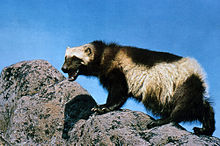Wolverine
For the Marvel comics character, see Wolverine (comics). Refer to Wolverine (disambiguation) for other uses of the term.
| Wolverine | |
|---|---|
| File:Wolverine perching.jpg | |
Invalid status (IUCN 2.3)
| |
| Scientific classification | |
| Kingdom: | |
| Phylum: | |
| Class: | |
| Order: | |
| Family: | |
| Genus: | Gulo Pallas, 1780
|
| Species: | G. gulo
|
| Binomial name | |
| Gulo gulo | |
The wolverine (Gulo gulo) is the largest species of the Mustelidae or weasel family, and is also called the glutton or carcajou. It is the only species currently classified in the genus Gulo. Three subspecies are recognised, the Old World form Gulo gulo gulo and the New World forms G. g. luscus and G. g. vancouverensis.
The wolverine has been recognized as endangered since 2003. It has been hunted because of the fine quality of its pelt.
Anatomy
The wolverine is a stocky and muscular omnivorous, but primarily carnivorous, animal. It has glossy brownish-black hair with stripes of light brown along the sides. The fur is long and dense and does not retain much water. This makes it very resistant to frost in the cold environment where wolverines live. The wolverine can weigh up to 25 kg (55 lb) (male), and is 70–110 cm (27–43 in) long with a 20 cm (8 in) tail. It resembles a small bear with a long tail. It has also been known to give off a strong, unpleasant odor, giving rise to the use of the term "skunk bear" to describe the animal.
Behavior
The wolverine is extremely strong for its size and has been known to kill animals as large as moose.[1] Its preference for reindeer has caused it to be hunted significantly in areas depending economically on caribou herds, and its status is sometimes in danger in such regions. It is generally not aggressive toward humans, preferring to avoid human contact. However, because a wolverine will attack an animal caught in a trap, early trappers often tried to kill them. They have been filmed capturing kills from other predators, such as polar bears or a wolf pack. Wolverines are the most ferocious of the Mustelidae family, and could easily dispatch all other Mustelids. Wolverines mate in the summertime, but implantation in the uterus is delayed until early winter, which delays the development of the fetus. Females will often not produce young if food is scarce. The young, usually three or four, are born in the spring. The young kits develop rapidly, becoming adult size within the first year of up to thirteen years of life.
Range

It currently primarily lives in arctic regions such as Alaska, northern Canada, Siberia and Scandinavia; wolverines also live in Russia and in the Baltic countries.
Before the wide-spread European settlement of North America, however, the wolverine was found as far south as the Sierra Nevadas in California; a few remain in the Rocky Mountain United States. The world's present wolverine population is unknown, it appears to have a very low population density throughout its domestic range, possibly consequent to illegal hunting. Wolverines, especially the males, require great home ranges. The wolverine is still trapped for its fur in some parts of its range.
Use as emblem
The U.S. state of Michigan is nick-named the Wolverine State, and the University of Michigan's sports teams are the Michigan Wolverines. The wolverine, however, is an uncommon sight in the state. One was observed in February 2004 by hunters and biologists near Ubly, the first time, in about two centuries, that in Michigan state, a wolverine had been positively identified. It is unknown if that particular animal was a state native or if it migrated or had been aided by humans.
The wolverine is the mascot of Wesley College, a small, co-educational liberal arts college in Dover, Delaware. It also is the mascot of Grove City College, a small, liberal arts Christian college in western Pennsylvania. During the U.S. Civil War, George Armstrong Custer was commanding officer of the Union Army Michigan troops named the "Wolverines". Moreover, West Potomac High School, a high school in Farifax County, Virginia, has a wolverine as mascot.
References
- Template:IUCN2006 Listed as Vulnerable (VU A2c v2.3)
The wolverine is the mascot of Westwood High School in Massachusetts and is the namesake to the famed student fan section of Westwood High, "The Wolverine Den." ...Wolverine Den Assemble!!!
